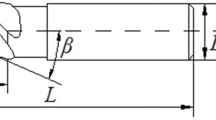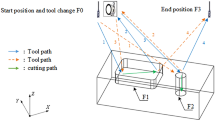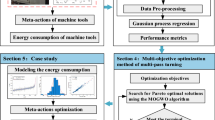Abstract
The application of the STEP-NC standard boosts the CNC machining industry towards integration plus automation. Cutting tool selection, considered as a primary task in the machining process, is generally carried out by the experience of the technologist, which cannot fit the highly integrated and automated STEP-NC environment. Therefore, a model-based cutting tool selection method is proposed in this paper. Energy consumption is introduced as an evaluation factor for the model of the cutting tool selection and the model’s data structure compatible with STEP-NC is established. The proposed model formulates the relationship between the cutting tool plus the related parameters and the energy consumption to provide a reliable evaluation criterion for the cutting tool selection. A genetic algorithm is used to guarantee that an optimized solution can be reached in the selection model conforming to STEP-NC standard, thus the information in the selection process can be recorded structurally to sound for further use. The actual cutting experiments of typical parts as case studies were tested to validate the effectiveness and feasibility of this cutting tool selection method.











Similar content being viewed by others
Data availability
All data generated or analyzed during this study are included in this published article and available at the corresponding author.
References
Balasubramaniam M, Joshi Y, Engels D, Sarma S, Shaikh Z (2001) Tool selection in three-axis rough machining. Int J Prod Res 39(18):4215–4238
Ding X, Lu Y, Fuh J, Lee K (2004) Optimal cutter selection for complex three-axis NC mould machining. Int J Prod Res 42(22):4785–4801
Ramaswami H, Shaw RS, Anand S (2011) Selection of optimal set of cutting tools for machining of polygonal pockets with islands. Int J Adv Manuf Technol 53(9–12):963–977
Ji W, Wang L, Haghighi A, Givehchi M, Liu X (2018) An enriched machining feature based approach to cutting tool selection. Int J Comput Integr Manuf 31(1):1–10
Edalew K, Abdalla H, Nash R (2001) A computer-based intelligent system for automatic tool selection. Materials & Design 22(5):337–351
Wang Y, Ma H, Gao C, Xu H, Zhou X (2005) A computer aided tool selection system for 3D die/mould-cavity NC machining using both a heuristic and analytical approach. Int J Comput Integr Manuf 18(8):686–701
Meseguer A, Gonzalez F (2008) A methodology for cutting-tool management through the integration of CAPP and scheduling. Int J Prod Res 46(6):1685–1706
Brenner D, Kleinert F, Imiela J, Westkamper E (2017) Life cycle management of cutting tools: comprehensive acquisition and aggregation of tool life data. In: Takata S, Umeda Y, Kondoh S (eds) 24th CIRP Conference on Life Cycle Engineering, Procedia CIRP 61:311–316
Li A, Zhao J, Gong Z, Lin F (2016) Optimal selection of cutting tool materials based on multi-criteria decision-making methods in machining Al-Si piston alloy. Int J Adv Manuf Technol 86(1–4):1055–1062
Wang B, Liu Z, Song Q, Wan Y, Shi Z (2016) Proper selection of cutting parameters and cutting tool angle to lower the specific cutting energy during high speed machining of 7050–T7451 aluminum alloy. J Clean Prod 129:292–304
Zhang X, Yu T, Dai Y, Qu S, Zhao J (2020) Energy consumption considering tool wear and optimization of cutting parameters in micro milling process. Int J Mech Sci 178
Wang CY, Zhao W, Liu Q, Chen HW (2017) Optimization of the tool selection based on big data. J Discret Math Sci Cryptogr 20(1):341–360
Zhou G, Yang X, Zhang C, Li Z, **ao Z (2019) Deep learning enabled cutting tool selection for special-shaped machining features of complex products. Adv Eng Softw 133:1–11
Tian C, Zhou G, Lu Q, Zhang J, **ao Z, Wang R (2019) An integrated decision-making approach on cutting tools and cutting parameters for machining features considering carbon emissions. Int J Comput Integr Manuf 32(7):629–641
Duan Y, Hou L, Leng S (2021) A novel cutting tool selection approach based on a metal cutting process knowledge graph. Int J Adv Manuf Technol 112(11):3201–3214
Avram OI, **rouchakis P (2011) Evaluating the use phase energy requirements of a machine tool system. J Clean Prod 19(6):699–711
Mori M, Fujishima M, Inamasu Y, Oda Y (2011) A study on energy efficiency improvement for machine tools. CIRP Ann 60(1):145–148
He Y, Liu F, Wu T, Zhong FP, Peng B (2012) Analysis and estimation of energy consumption for numerical control machining. Proc Inst Mech Eng B J Eng Manuf 226(2):255–266
Chen X, Li C, ** Y, Li L (2018) Optimization of cutting parameters with a sustainable consideration of electrical energy and embodied energy of materials. Int J Adv Manuf Technol 96(1):1–14
Gutowski T, Dahmus J, Thiriez A (2006) Electrical energy requirements for manufacturing processes. 13th CIRP International Conference of Life Cycle Engineering 96(1):1–14
Li W, Kara S (2011) An empirical model for predicting energy consumption of manufacturing processes: a case of turning process. Proc Inst Mech Eng B J Eng Manuf 225(9):1636–1646
Li L, Yan J, **ng Z (2013) Energy requirements evaluation of milling machines based on thermal equilibrium and empirical modelling. J Clean Prod 52(52):113–121
Liu N, Zhang Y, Lu W (2015) A hybrid approach to energy consumption modelling based on cutting power: a milling case. J Clean Prod 104:264–272
Pobozniak J, Sobieski S (2017) Extension of STEP-NC data structure to represent manufacturing process structure in CAPP system. Procedia Manufacturing 11:1692–1699
Peng T, Xu X (2014) A holistic approach to achieving energy efficiency for interoperable machining systems. Int J Sustain Eng 7(2):111–129
Peng T, Xu X (2017) An interoperable energy consumption analysis system for CNC machining. J Clean Prod 140:1828–1841
Wang H, Xu X, Zhang C, Hu T (2017) A hybrid approach to energy-efficient machining for milled components via STEP-NC. Int J Comput Integr Manuf 31:442–456
Wang H, Zhong RY, Liu G, Mu W, Tian X, Leng D (2019) An optimization model for energy-efficient machining for sustainable production. J Clean Prod 232:1121–1133
ISO 14649-10 (2004) Industrial automation systems and integration - physical device control - data model for computerized numerical controllers - part 10: General process data
ISO 14649-11 (2004) Industrial automation systems and integration - physical device control - data model for computerized numerical controllers - part 11: Process data for milling
ISO 14649-111 (2010) Industrial automation systems and integration - physical device control - data model for computerized numerical controllers - part 111: Tools for milling machines
ISO 14649-201 (2011) Industrial automation systems and integration - physical device control - data model for computerized numerical controllers - part 201: Machine tool data for cutting processes
Li C, Wang H, Wang Z (2016) Calculation of material removal rate in milling cutting process. Tool Engineering 50(1):55–60
**n A, SG (2002) Concise manual of cutting parameters. China Machine Press, Bei**g
Acknowledgements
The author would like to thank the Intelligent Computing for Aerospace Technology Laboratory.
Funding
This work was supported by the National Natural Science Foundation of China [61972011] and [5217053342].The National Natural Science Foundation of China [62102011] also supported the article.
Author information
Authors and Affiliations
Contributions
Gang Zhao: supervision, methodology, reviewing. Kang Cheng: writing, original draft preparation, software development, validation, cutting experiments. Wei Wang: methodology, reviewing, editing. Yazui Liu: structure, reviewing, editing. Zhihua Dan: data processing.
Corresponding author
Ethics declarations
Ethics approval
Not applicable.
Consent for publication
The author signs for and accepts responsibility for releasing this material on behalf of any and all co-authors.
Conflicts of interest
The authors declare that they have no conflict of interest.
Additional information
Publisher’s Note
Springer Nature remains neutral with regard to jurisdictional claims in published maps and institutional affiliations.
Rights and permissions
About this article
Cite this article
Zhao, G., Cheng, K., Wang, W. et al. A milling cutting tool selection method for machining features considering energy consumption in the STEP-NC framework. Int J Adv Manuf Technol 120, 3963–3981 (2022). https://doi.org/10.1007/s00170-022-08964-0
Received:
Accepted:
Published:
Issue Date:
DOI: https://doi.org/10.1007/s00170-022-08964-0







